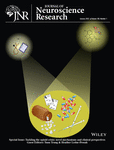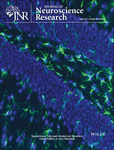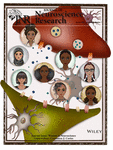Journal list menu
Export Citations
Download PDFs
COVER
Cover
- Page: i
- First Published: 13 July 2022
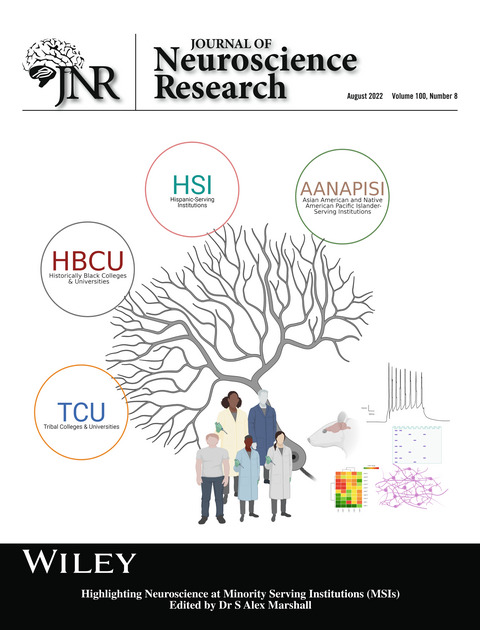
Minority serving institutions (MSIs) are in a unique position to contribute to the Neuroscience field by increasing the diversity in the workforce through trainees, but those institutions, trainees, and their faculty mentors are able to simultaneously propel the field forward in advances in cutting-edge neuroscience research. Enclosed are a few examples of neuroscience laboratories at MSIs from across the country who are engaged in neuroscience research, including North Carolina Agricultural and Technical State University, Delaware State University, the University of Texas at El Paso, North Carolina Central University, University of North Texas, and Ponce Health Sciences University. In this neuronal depiction, the “dendritic” inputs from various categories of MSIs are diversifying the workforce and producing data that feeds into the field’s “axon”. (Special Note: MSIs also include Alaska Native & Native Hawaiian Serving Institutions; Native American Indian Serving, Non-Tribal Institutions; and Predominately Black Institutions.)
ISSUE INFORMATION
COMMENTARY
Highlighting the contributions of Minority Serving Institutions to neuroscience
- Pages: 1527-1528
- First Published: 19 May 2022
Reflections of six neuroscientists: The influences of training at minority serving institutions
- Pages: 1529-1537
- First Published: 01 February 2021
Diversity in neuroscience education: A perspective from a Historically Black institution
- Pages: 1538-1544
- First Published: 14 July 2021
The National Institute of Neurological Disorders and Stroke’s efforts on diversifying the neuroscience research workforce
- Pages: 1545-1550
- First Published: 03 June 2021
RESEARCH ARTICLES
The dopamine membrane transporter plays an active modulatory role in synaptic dopamine homeostasis
- Pages: 1551-1559
- First Published: 08 November 2021

The pH-sensitive fluorescent sensor remains OFF inside neurotransmitter vesicles due to low pH. Upon fusion of the vesicle with the synaptic membrane, the sensor is exposed to the neutral extra-cellular pH which switches it to the ON configuration. Fluorescence recovery after photo-bleaching imaging of vesicle fusion dynamics reveals an active role for the dopamine membrane transporter in synaptic dopamine homeostasis.
Adolescent intermittent ethanol exposure induces sex-dependent divergent changes in ethanol drinking and motor activity in adulthood in C57BL/6J mice
- Pages: 1560-1572
- First Published: 16 March 2021
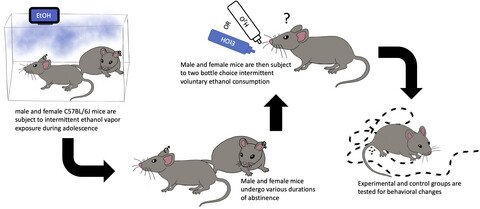
Voluntary ethanol consumption was assessed following short- and long-term abstinence after adolescent intermittent ethanol exposure. * Intermittent vapor ethanol exposure during adolescence induces sexually divergent changes in ethanol consumption in adulthood. Long-term changes in open field behavior were observed in male and female C57BL/6J mice.
Amino acid systems in the interpeduncular nucleus are altered in a sex-dependent manner during nicotine withdrawal
- Pages: 1573-1584
- First Published: 22 March 2021
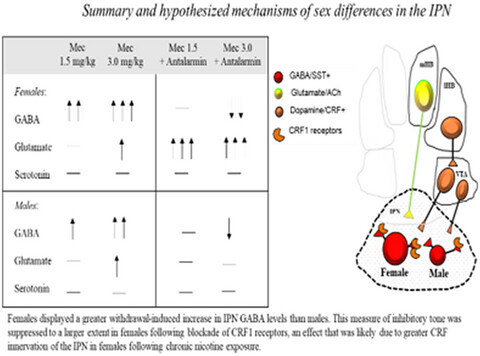
Females displayed a greater withdrawal-induced increase in interpeduncular nucleus (IPN) γ-aminobutyric acid levels than males. This measure of inhibitory tone was suppressed to a larger extent in females following blockade of corticotropin-releasing factor type 1 (CRF1) receptors, an effect that was likely due to greater CRF innervation of the IPN in females following chronic nicotine exposure.
Pharmacological activation of the Sonic hedgehog pathway with a Smoothened small molecule agonist ameliorates the severity of alcohol-induced morphological and behavioral birth defects in a zebrafish model of fetal alcohol spectrum disorder
- Pages: 1585-1601
- First Published: 11 January 2022
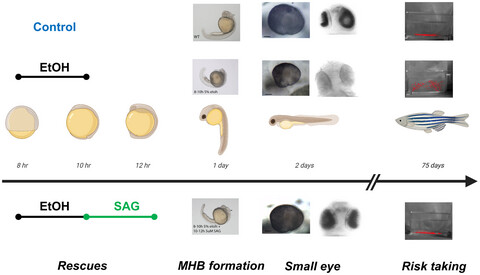
Exposure of zebrafish embryos to acute ethanol during the late gastrulation phase (8–10 hpf) results in defects in brain development (midbrain–hindbrain boundary formation; microphthalmia) and long-lasting behavioral deficits (increase in risk taking behavior). The addition of a sonic hedgehog pathway agonist to the zebrafish embryos immediately after the ethanol exposure (10–12 hpf) rescues both the short-term morphological and long-term behavioral defects.
REVIEW
Aerobic exercise as a promising nonpharmacological therapy for the treatment of substance use disorders
- Pages: 1602-1642
- First Published: 01 December 2021





